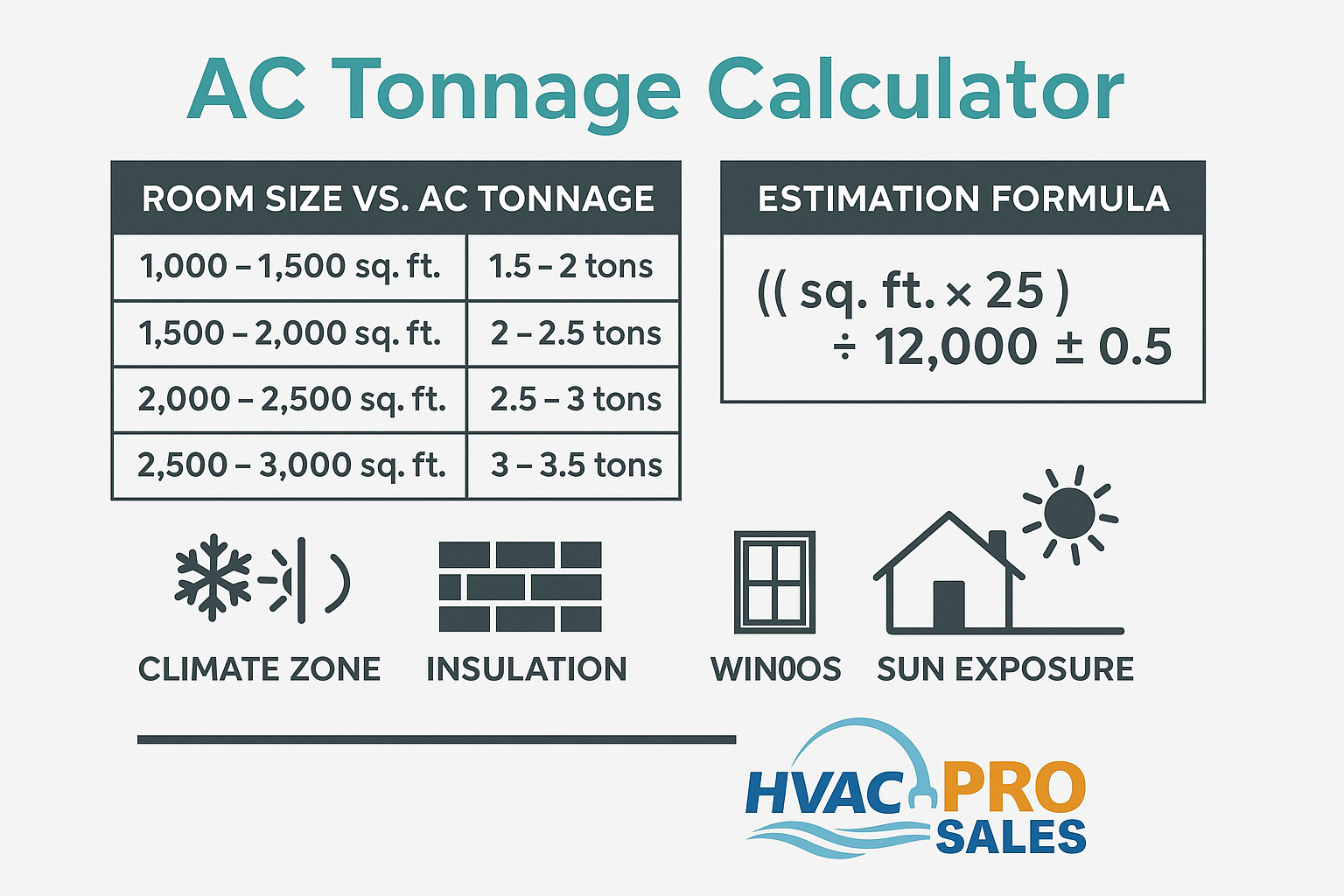AC Tonnage Calculator 2025 – Find Central AC Size & BTU
Jul 8th 2025
AC Tonnage Calculator – Find Your Ideal Central Air Size (2025)

Choosing the right size central air conditioner is critical to comfort, efficiency, and system lifespan. Use an AC tonnage calculator to estimate your home's ideal BTU/tonnage — then refine with proper load calculations. At HVACProSales.com, we help you understand how sizing works and guide you to the parts and tools you’ll need.
? What Is AC Tonnage?
“Tonnage” in HVAC refers to the cooling capacity of a system. One ton equals **12,000 BTUs/hour**. So a 2-ton system provides 24,000 BTUs of cooling per hour. :contentReference[oaicite:1]{index=1}
⚖️ Why Proper Sizing Matters
- If too small: Your system runs constantly, fails to cool evenly, and wears out faster.
- If too large: It cycles too quickly, can’t remove humidity effectively, and wastes energy. :contentReference[oaicite:2]{index=2}
? Estimating AC Size: The Simple Method
A basic formula used in industry estimates is: ((sq ft × 25) ÷ 12,000) ± 0.5 For example, a 2,400 sq. ft. home: ((2,400 × 25) ÷ 12,000) = 5.0 tons Then adjust by plus or minus 0.5 depending on insulation, climate, and other factors. :contentReference[oaicite:3]{index=3}
? Climate Zones & Insulation Adjustments
Your region and insulation quality greatly impact your required tonnage:
- Hotter, humid zones need more capacity per sq ft. :contentReference[oaicite:4]{index=4}
- Better-insulated homes may allow you to size slightly lower.
- High ceilings, many windows, or poor sealing increase cooling demand.
? Sample Tonnage & BTU Chart
| House Size (sq ft) | Estimated Tonnage | BTU Range |
|---|---|---|
| 1,000 – 1,500 | 1.5 – 2.0 ton | 18,000 – 24,000 BTU |
| 1,500 – 2,500 | 2.0 – 3.5 ton | 24,000 – 42,000 BTU |
| 2,500 – 3,500 | 3.0 – 4.5 ton | 36,000 – 54,000 BTU |
| 3,500 – 5,000+ | 4.5 – 5.0+ ton | 54,000 – 60,000+ BTU |
? The Manual J: Professional Calculation
The **Manual J load calculation** is the industry standard — it considers every detail like duct losses, solar gains, occupancy, equipment loads, and more. Many HVAC contractors include this in their quotes. :contentReference[oaicite:5]{index=5}
? Adjustments & Safety Margins
- Do not oversize above ~15% of your calculated tonnage. :contentReference[oaicite:6]{index=6}
- Allow room for future expansion (if you plan to finish spaces).
- Always check duct capacity and static pressure — size is not just about the outdoor unit.
✅ How to Use This on Your HVACProSales Workflow
- Estimate using square footage formula above.
- Refine using a Manual J or contractor assessment.
- Select matching unit brands and models (e.g., 16-SEER, inverter, dual-stage).
- Order necessary installation kits, tools, line sets & parts.
? Pricing & Size Examples
Typical central AC units range from ~1.5 tons (18,000 BTU) to 5 tons (60,000 BTU). :contentReference[oaicite:7]{index=7} Costs increase with tonnage. RemodelingCalculator cites average install project costs between $4,270 – $5,930 depending on tonnage and region. :contentReference[oaicite:8]{index=8}
⛔ Why “Bigger is Better” is Dangerous Thinking
Oversizing leads to poor humidity control, short cycling, higher energy bills, and wear on components. Under-sizing, conversely, means your AC struggles in hot climates. Strive for the right balance. :contentReference[oaicite:9]{index=9}
Frequently Asked Questions
What’s the smallest central AC I can have?
Residential units typically start at ~1.5 tons (18,000 BTU). Most homes need 2+ tons. :contentReference[oaicite:10]{index=10}
Can I oversize by 1 ton and be safe?
No — oversizing above 15% often causes humidity and performance issues. :contentReference[oaicite:11]{index=11}
Is square footage method reliable?
Only as a rough guide. For best results, run a Manual J or professional load assessment. :contentReference[oaicite:12]{index=12}
© 2025 HVACProSales.com | Contact Us | Shipping & Returns | Privacy Policy
